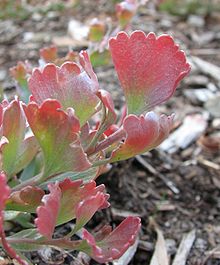Kwongan
| Localització | |||
|---|---|---|---|
| Entitat territorial administrativa | Austràlia Occidental | ||
| Localització | Austràlia sudoccidental | ||

Kwongan és una ecoregió que es troba al sud-oest d'Austràlia Occidental. El seu nom prové de l'idioma dels aborígens Noongar i va ser definit per Beard (1976) com un indret sorrenc i obert sense grans arbres i amb vegetació arbustiva. Hi ha dos tipus principals de vegetació al Kwongan: arbusts de bruguerar i grups de plantes genistoides.
Aquest terme ha esdevingut corrent a Austràlia i és més o menys equivalent al de fynbos a Sud-àfrica, chaparral a Califòrnia, maquis a França i el de matorral a Xile i en totes aquestes regions hi ha un clima mediterrani.
La població de Wongan Hills deriva el seu nom del kwongan.
El primer llibre dedicat al kwongan (Pate i Beard 1984) intentà separar l'aplicació d'aquest terme dels indrets sorrencs que havien aplicat tradicionalment els Noongars. Beard i Pate (1984) preferien aplicar-lo estrictament a la vegetació.
L'ecoregió Kwongan és extensa i ocupa una quarta part de la Regió florística australiana del sud-oest i conté un 70% de les 8.000 espècies de plantes natives d'aquest regió florística (Beard i Pate 1984; Hopper i Gioia 2004). La meitat de les seves espècies són endèmiques.
Conservació[modifica]
Científics de la University of Western Australia han proposat que aquesta regió sigui declarada Patrimoni de la Humanitat.[1]
Referències[modifica]
- ↑ Wahlquist, Calla. «Western Australian scientists push for world heritage status for area size of England». The Guardian, 10-02-2015. [Consulta: 11 març 2015].
Beard, J.S. 1976. An indigenous term for the Western Australian sandplain and its vegetation. Journal of the Royal Society of Western Australia 59, 55-57.
Beard, J.S., Pate, J.S. 1984. Foreword: Kwongan – Plant Life of the Sandplains. Pp xvii-xxi in J.S. Pate & J.S. Beard, eds. Kwongan—Plant Life of the Sandplain. University of Western Australia Press, Ned- lands
Bindon, P., Chadwick, R., eds. 1992. A Nyoongar wordlist from the south-west of Western Australia. Western Australian Museum, Perth.
Brooke, J.P. 1896. Natural features of Israelite Bay. Proceedings Australasian Association for the Advancement of Science 6, 561-569.
Dench, A. 1994. Nyungar. Pp. 173-192 in N. Thieberger & W. McGregor, eds, Macquarie Aboriginal Words. The Macquarie Library, Macquarie University, NSW.
Diels, L. 1906. Die Pflanzenwelt von West-Australien südlich des Wendekreises. Vegn. Erde VIII. Leipzig.
Douglas, W.H. 1976. The Aboriginal languages of the southwest of Australia. 2nd ed. Australian Institute of Aboriginal Studies, Canberra
Drummond, J. 1839. Hookers Journal of Botany 2, 307, 356.
Erickson, R. 1969. The Drummonds of Hawthornden. Lamb Paterson, Osborne Park WA.
Eyre, E.J. 1845. Journals of expeditions of discovery into central Australia and overland from Adelaide to King George’s Sound in the years 1840-1. T. & W. Boone, London.
Gardner, C.A. 1942. The vegetation of Western Australia with special reference to climate and soils. Journal of the Royal Society of Western Australia 28, 11-87.
Hercock, M., Milentis, S., Bianchi, P. 2011. Western Australian Exploration 1836 – 1845. Hesperian Press, Victoria Park.
Hopper, S.D. 2009. OCBIL theory: towards an integrated understanding of the evolution, ecology and conservation of biodiversity on old, climatically-buffered, infertile landscapes. Plant and Soil 322, 49-86.
Hopper, S.D., Gioia, P. 2004. The Southwest Australian Floristic Region: evolution and conservation of a global hotspot of biodiversity. Annual Review of Ecology, Evolution and Systematics 35, 623-650.
Moore, G.F. (1842). A descriptive vocabulary of the language in common use amongst the Aborigines of Western Australia; with copious meanings, embodying much interesting information regarding the habits, manners, and customs of the natives, and the natural history of the country. William S. Orr and Co., London. Reprinted 1884.
Moule, M. 2009. A reliable mass propagation system for Ravensthorpe Radish (Platysace deflexa). Centre for Natural Resource Management, The University of Western Australia, Albany.
Pate, J.S., Beard, J.S., eds. 1984. Kwongan—Plant Life of the Sandplain. University of Western Australia Press, Nedlands. Von Brandenstein, C.G. 1988. Nyungar Anew. Pacific Linguistics Ser. C99, i-xxiv & 1-180.
- Lambers, H. (ed.) (2014) "Plant Life on the Sandplains in Southwest Australia, a Global Biodiversity Hotspot". UWA Publishing, Crawley.
